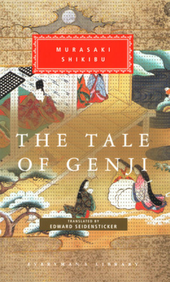A WRITER'S WIT |
My book World

I read this tome of 1,184 pages aloud to my partner for numerous evenings over three months. I believe there were several advantages to digesting the work in this manner. One, even though it is a translation, one does sense the delicacy of the Japanese royal court depicted in the early 11th century, the apparent highly educated level of its men and women. I selected this book because author Jane Smiley includes it as number one in her list of 100 books found in Thirteen Ways of Looking at the Novel, and I was curious. Reading aloud also prevents the reader from falling asleep from the apparently repetitive or rhythmic nature (heavily tied to the seasons) of the narrative. Many rituals also are linked to certain days of certain months. Finally, I believe, there is a narrative tone that I, as the reader, am finally able to master to some degree, reading exposition one way, dialogue (according to each character) in another, the poetic passages in yet another. At least I believe so.
Most scholars, including Smiley, consider this book the first novel. In large part that may be true. The complex narrative does sustain itself over a long period, more than fifty years, exploring the lives of two primary characters (Genji and his son) and their cohorts. However, there exist some differences. Many times Genji feels like a long narrative that drifts from story to story, as one wanders from room to room of the sprawling architecture of the court’s many palaces. Genji may be the first novel but only in the same way that a Model-T Ford is one of the earliest mass-produced cars. It’s a bit primitive, a suggestion of what is to come.
Shikibu does make great use of figurative language, particularly as it relates to nature, as well as the supernatural. She employs trees, flowers, bramble, snow, rain, wind to make comparisons. At the same time, she speaks, on behalf of characters who must believe in this heavily Buddhist period, of former lives now paying for past sins. They follow the Blessed One, are bothered by evil or devilish spirits who, among other things, cause characters to become ill or die. Spirits seem to be a continuation of life on Earth. They can’t accept the peace of death. Furthermore, Shikibu uses foreshadowing to great effect. The savvy reader catches these and appreciates her arrow-pointing. At the same time, Shikibu has some practices that seem underdeveloped. Often, in dialogue, she does not remind the reader who is speaking. And though the omniscient narrator has for a long time been a literary convention, Shikibu herself shifts to the first person numerous times through sly, wink-and-a-nod sort of asides—most often to excuse herself for not adding more detail to a certain scene: “There were many others [poems], but I neglected to set them down” (727). These instances seem clumsy compared to how that POV has been handled since the nineteenth century. She also demonstrates an odd sense of narrative pace, often extending a single scene over pages but passing over a longer era by way of a single sentence. A stylistic quirk, or lack of development?
Though Genji is presented as one tome, it is in reality two separate books. The eponymous character, Genji, dies at the end of chapter forty-one. The second part of the narrative is about his heirs. It seems that the first part is more complex, more alive, whereas the complexity of the second part diminishes to no more than a romance novel. But even this characteristic may be the result of serious intent on the part of Shikibu. Perhaps she wishes to portray a certain vapidity among the royals, whose voluptuous but empty lives are repeated again and again throughout the centuries by way of their own progeny. She may also be portraying a social transition. This work is more or less the view of the court, for even the royal servants have status that ordinary Japanese outside of its realm do not have. There is no mention of Samurai warriors or a military or any kind. No battles. No skirmishes that are found in the writing of male novelists, giving the book a uniquely feminine flair. One final thought: Shikibu does not seem to capture at a sophisticated level the characters’ emotions. The only exception may be the emotion of sadness, during which times she refers to their copious tears or their weeping or crying. There seems to be little joy or the portrayal of even ordinary emotions. Perhaps she is only portraying the culture as it appears to her, one where most royals hide their emotions from each other.
It seems that this book is much more complex and sophisticated than anything that was happening in Europe at the same time (one may disagree). The use of indirection alone is something that Jane Austen or Alcott would employ much later in time. During any other era I might not have taken the time to read this book, but given the need to do something constructive during the evenings of Covid, I think it a great gift to have done so now.
FRIDAY, 12/4/20: My Book World | Oscar Lewis's Five Families



 RSS Feed
RSS Feed